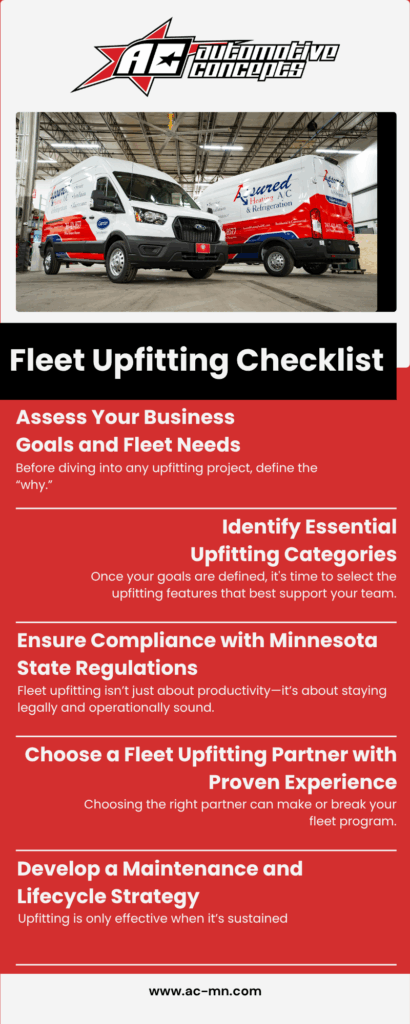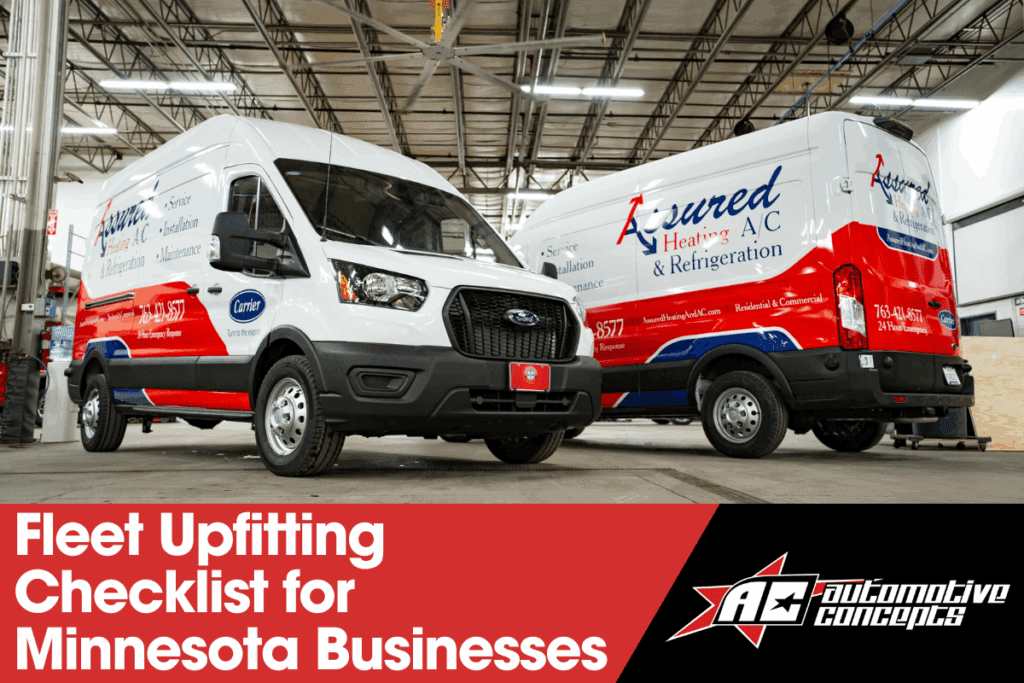In Minnesota’s fast-moving commercial landscape, operational efficiency is everything. Whether you’re managing a construction fleet, delivering goods across the Twin Cities, or servicing clients in Greater Minnesota, your vehicles are more than just transport—they’re the face of your brand. At Automotive Concepts, we believe fleet upfitting isn’t just an enhancement—it’s a strategic transformation.
This comprehensive Fleet Upfitting Services Checklist is designed to help Minnesota business owners make informed, confident decisions that enhance performance, safety, and brand presence—all backed by precision installation and industry-leading quality.
Assess Your Business Goals and Fleet Needs
Before diving into any upfitting project, define the “why.” Each business has unique operational challenges, and understanding them ensures your vehicle modifications provide true ROI.
Key Questions to Ask:
- What daily functions must each vehicle perform?
- What pain points are drivers currently experiencing?
- Do your vehicles reflect your company’s professionalism and branding?
- Are seasonal demands or regional terrains influencing equipment decisions?
Regional Context:
Minnesota fleets often contend with extreme winters, rural travel, and off-road terrains. Whether you’re in Minneapolis or Mankato, planning for all four seasons is essential.
Common Sector-Specific Fleet Goals:
- Plumbing and Electrical: Rapid tool access, secure drawer systems, and in-vehicle power.
- Telecom & Utility: Generator mounting, hydraulic lifts, and safety lighting.
- Public Safety: Custom command center builds with in-cab communication systems.
- Snow Removal & Landscaping: Exterior mounts, plow lighting, and salt spreader harnesses.
Knowing your niche helps tailor your fleet for maximum functionality, saving both time and costs in the long run.
Identify Essential Upfitting Categories

Once your goals are defined, it’s time to select the upfitting features that best support your team. These upgrades should optimize both vehicle function and driver experience—especially critical in high-use environments.
Must-Consider Categories:
Interior Modifications:
- Shelving and Racking: Adjustable units for different tool sizes.
- Partitions and Bulkheads: Keep drivers safe from shifting cargo.
- Climate Control Enhancements: Supplemental heating or insulation for temperature-sensitive equipment.
Exterior Equipment:
- Roof Racks and Ladder Systems: Optimize storage for tall or awkward cargo.
- Side Steps and Grille Guards: Ensure safe ingress, especially in icy conditions.
- Toolboxes and Secure Compartments: Keep high-value equipment locked and accessible.
Electrical and Auxiliary Systems:
- Remote Start: Minimizes downtime in frigid temperatures.
- Power Inverters: Allow use of 120V tools on-site.
- LED Beacons and Scene Lighting: Required for night work or emergency situations.
Branding & Visibility:
- Custom Graphics: Ensure all vehicles reflect your brand identity across the region.
- Reflective Striping: Improves nighttime visibility and meets DOT compliance.
Minnesota-Specific Add-ons:
- Undercoating for salt corrosion resistance
- Heated mirrors and defrost grid systems
- Backup sensors enhanced for snowy or icy conditions
Selecting modular systems allows your fleet to evolve over time without costly overhauls.
Ensure Compliance with Minnesota State Regulations
Fleet upfitting isn’t just about productivity—it’s about staying legally and operationally sound. Minnesota follows both federal FMCSA guidelines and local commercial vehicle requirements, making compliance a non-negotiable element of any upfit.
Key Regulatory Considerations:
- DOT Lighting Rules: Vehicle lighting must meet brightness, positioning, and color requirements—particularly for service vehicles and trailers.
- Axle Load Limits: Ensure any new equipment doesn’t push vehicles over gross vehicle weight ratings (GVWR).
- ADA Compliance: For passenger transport, lifts and accessibility equipment must meet specific specs.
- Noise and Emissions: Engine idle laws and emission compliance may apply in metro areas.
Common Mistakes to Avoid:
- Mounting auxiliary systems that interfere with OEM electronics
- Installing shelving systems that block required exits or emergency windows
- Exceeding height/length limits after installing roof-mounted gear
Working with a certified upfitter ensures everything from bolt strength to cable routing meets local codes and preserves OEM warranties.
Choose a Fleet Upfitting Partner with Proven Experience
Choosing the right partner can make or break your fleet program. Upfitting is not just hardware installation—it’s the intersection of logistics, design, engineering, and support.
Why Work with a Minnesota-Based Specialist:
- Local Expertise: Understanding climate, road salt impact, and driving patterns.
- Faster Turnaround: No long-distance shipping delays or out-of-state logistics.
- Ongoing Support: Easy access to service and warranty handling.
- Fleet Consistency: In-house design teams can standardize components across all vehicle types.
What to Look for in a Partner:
- Fleet project management (intake, documentation, timelines)
- Dedicated account reps and centralized billing
- Vendor certifications and ongoing training
- Proven experience with your vehicle make and sector
Explore our Fleet Upfitting Services in Minnesota and discover why hundreds of regional businesses choose Automotive Concepts for precision, reliability, and scalable expertise.
Develop a Maintenance and Lifecycle Strategy
Upfitting is only effective when it’s sustained. Don’t let corrosion, wear, or forgotten accessories undercut your investment.
Maintenance Priorities:
- Hardware Inspection: Quarterly checks on racks, shelving bolts, and electrical wiring.
- Electronics Diagnostics: Seasonal testing of remote start, lighting circuits, and dash cams.
- Surface Protection: Touch-ups for powder coating and underbody inspection post-winter.
Driver Training Essentials:
- Safe loading/unloading procedures
- How to operate auxiliary equipment
- Basic troubleshooting (e.g., inverter resets)
Lifecycle Management:
- Plan updates every 3–5 years based on vehicle usage
- Standardize configurations to reduce training gaps
- Use downtime or seasonal lulls for major upgrades
A strategic maintenance plan helps extend the life of both the vehicle and the upfit, reducing total cost of ownership.
Conclusion: Elevate Your Fleet Without Compromise
Your fleet is an extension of your brand and a pillar of your daily operations. The right upfitting approach transforms it into a powerful tool—efficient, safe, and unmistakably professional.
At Automotive Concepts, we bring the same passion and precision to fleet upfitting as we do to every custom vehicle transformation. Whether you’re equipping a new fleet or retrofitting existing assets, our Minnesota-based team is here to elevate your standards—without compromise.
Ready to take the next step? Learn More
Frequently Asked Questions
What is the typical turnaround time for fleet upfitting?
Turnaround times vary based on fleet size and complexity, but most small to mid-sized fleet projects are completed within 2–4 weeks after approval and parts procurement.
Do you offer warranties on fleet upfit installations?
Yes, Automotive Concepts backs its upfit installations with limited warranties on both parts and labor. Contact us for specific coverage details based on your project.
Can fleet upfits be customized per vehicle or role?
Absolutely. Whether you have a uniform fleet or diverse vehicle roles, our team designs each upfit around your operational needs, ensuring form meets function.

